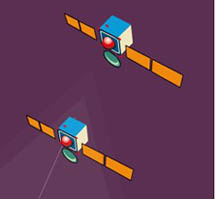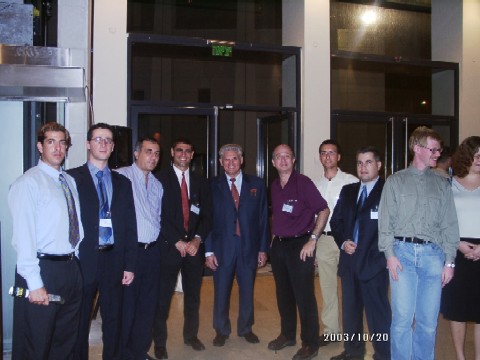Among the customers who will receive service from the satellite: the American company HBO and the German RTL
28.11.2003
 The Israeli communication satellite "Amos" 2 will be launched into space on December 25, on top of the Russian "Soyuz" rocket launcher, from the Baikonur launch site in Kazakhstan. "Amos" 2 is a second generation of communication satellites built at the Israeli Aerospace Industries (IAI) plant. The first satellite, "Amos 1," was launched in April 1996. The coverage areas of Amos 2 include the Middle East and Europe. It is able to transmit the broadcasts with greater power, directly to homes that will receive them using small antennas. Its weight is about 1.4 tons, it will be launched to an altitude of 36 thousand km above the earth, and will be placed in space near Amos 1. This location will allow the use of one antenna in space for both satellites.
The Israeli communication satellite "Amos" 2 will be launched into space on December 25, on top of the Russian "Soyuz" rocket launcher, from the Baikonur launch site in Kazakhstan. "Amos" 2 is a second generation of communication satellites built at the Israeli Aerospace Industries (IAI) plant. The first satellite, "Amos 1," was launched in April 1996. The coverage areas of Amos 2 include the Middle East and Europe. It is able to transmit the broadcasts with greater power, directly to homes that will receive them using small antennas. Its weight is about 1.4 tons, it will be launched to an altitude of 36 thousand km above the earth, and will be placed in space near Amos 1. This location will allow the use of one antenna in space for both satellites.
Among the customers who have already signed contracts to receive service from the satellite are the Israeli government, the "Yes" company, the Israeli Broadcasting Authorities, Gilat Satellites, as well as European TV stations, including RTL from Germany and HBO, the largest pay TV company in the USA (which broadcasts between (except the series "Sex and the Great City" and "The Sopranos").
Amos 2 is owned by the HLL company, which invested about 130 million dollars in the project, some of it by raising capital through the issuance of bonds.
"Amos 2 is owned by the H-L-L company that invested about 130 million dollars in the project, some of it by raising capital through the issuance of bonds. CEO David Polak said that the investment includes the production cost of the satellite, approximately $70 million, the launch cost, approximately $35 million, and the insurance premiums - approximately $25 million. He noted that so far the company has sold about 70% of the satellite's transmission capacity and according to him this is a respectable marketing achievement. "Amos" 1 was launched into space even before it had a single customer.
Polk said that after the launch is crowned with success, the HLL company will begin raising the necessary capital to build "Amos" 3 which will be launched in 2007 and replace "Amos" 1 which will probably end its life in 2008. The third generation satellite will weigh about two tons and its price will be About 160 million dollars. In a partnership, in equal parts, the companies: TAA, Eurocom Holdings, Ch. Mr. and the general company for satellite services owned by retired general Meir Amit and the Roteloi family. Amit serves as the chairman of the board of directors of the H-L-L company.
Minister Modi Zandberg at the reception for the cosmonaut: Amos 2 will be launched by a Russian rocket
21.10.2003
By: Avi Blizovsky
In the photo: the heads of the Israel Space Association with cosmonaut Volinov
On 20/10, a reception was held at the Air Force House in Herzliya for the Russian cosmonaut Boris Volinov, who was a guest of the Fisher Institute for Strategic Air and Space Research.
The Minister of Science, Modi Zandberg, who hosted the event, spoke in praise of the Russian space program and said that the International Space Station is the largest cooperation project in the world - Kipu is expected to reach one hundred billion dollars in its 15 years of existence. Russia, the USA, Japan, the European Union and Canada are partners in the project. Following the Columbia disaster in February of this year, the only contact with the International Space Station was made through Russian Soyuz spacecraft bringing astronauts to the station and automated Russian spacecraft bringing supplies using Progors rockets.
The Russians were the first to send an astronaut into space, Yuri Gagarin, and were also the first to send a woman into space - Valentina Tereshkova.
The Mir space station served as a school for Russian cosmonauts and American astronauts when it comes to man's long-term stay in space. To this day, the Russians continue to hold the record for space travel. more than a year.
Israeli-Russian co-operation in space: (launch) Tavex as part of an international Russian project in which Israel participated. which unfortunately did not come to fruition due to financial reasons. The Technion students' satellite weighing 48 kg was launched into space in 1998 using a Russian launcher. The long satellite of ImageSat, a company jointly owned by the aerospace industry, was built by the aerospace industry and launched into space in 2000 by a Russian launcher. Following the failure of the French Ariane rocket, the Israeli communication satellite Amos 2 is planned to be launched into space at the end of 2003 using a Russian launcher. The satellite weighs more than a ton and will provide communication services to Israel and Eastern Europe, as well as high-speed internet services from space from Israel to the USA.
There is room for cooperation between Israel and Russia in light of the fact that many scientists in Israel speak Russian.
After receiving symbolic gifts from representatives of the aviation industry and the Fisher Institute, Volinov went on stage with the help of an interpreter and said that due to being Jewish, he paid special attention to Israel and watched it many times from space. He thanked his hosts for the respect they show him during his visit and also said that during his stay in space he was many times on the brink of death and thanked luck and resourcefulness that helped him escape from it.

